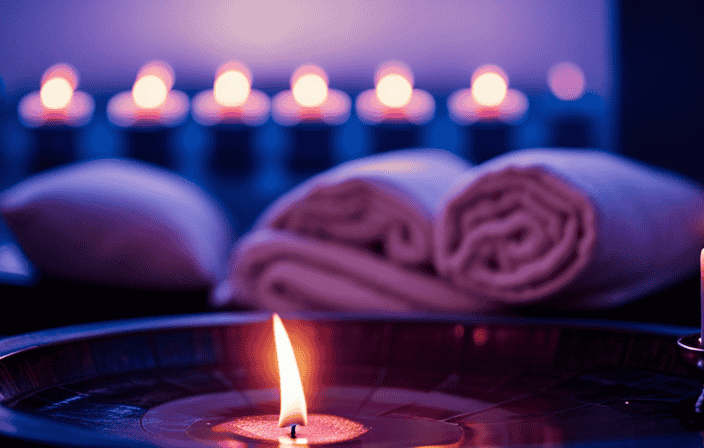I understand you may be skeptical, but trust me, yoga and meditation can be beneficial for managing migraines.
While they may not be a cure-all, yoga and meditation have been proven to provide significant relief for those suffering from migraines.
Not only do they reduce stress and promote body awareness, but they can also alleviate headaches and migraines.
So before you dismiss them, let’s explore how combining yoga and meditation can be a winning formula for a migraine-free life.
Key Takeaways
- Movement meditation combines meditation with gentle physical movement and can alleviate headaches and migraines.
- Yoga poses such as Child’s Pose, Forward Fold, Bridge Pose, and Legs-Up-The-Wall Pose are beneficial for migraines.
- Maintaining a regular sleep schedule, managing stress levels, and practicing relaxation techniques are recommended for migraine management.
- Both yoga and meditation offer valuable tools for managing migraines, and combining them can be a winning formula for a migraine-free life.
What is it?
I find that both yoga and meditation offer valuable tools for managing migraines. They provide a holistic approach to migraine relief, addressing both the physical and mental aspects of the condition.
Yoga combines gentle stretches with controlled breathing, reducing the frequency and severity of migraines. It promotes relaxation, releases tension, and improves overall well-being.
Meditation, on the other hand, calms the mind, redirects attention away from pain, and fosters a sense of inner peace and relaxation. It can be especially beneficial during a migraine attack, as finding a quiet and calm environment to rest and practicing relaxation techniques can provide relief.
Additionally, I have found that medical cannabis, specifically CBD, has been effective in managing chronic pain associated with migraines.
Overall, combining yoga and meditation can be a winning formula for a migraine-free life.
Benefits of Movement Meditation
Movement meditation combines gentle physical movement with mindfulness practices, offering a holistic approach to reducing stress, promoting body awareness, and improving overall well-being. It is a wonderful option for individuals who struggle with sitting still during traditional meditation.
Here are three key benefits of movement meditation:
-
Stress reduction: Moving the body while focusing on the breath and present moment helps to release tension and calm the mind. This can significantly reduce stress levels and promote relaxation.
-
Body awareness: By incorporating gentle physical movements, movement meditation cultivates a deeper connection between the mind and body. This increased body awareness can enhance proprioception and help individuals better understand and respond to their body’s needs.
-
Headache and migraine relief: Movement meditation has been found to alleviate headaches and migraines. By bringing attention to sensations in the body and using controlled breathing, it can help to reduce the frequency and severity of migraines.
Incorporating movement meditation into your routine can have profound effects on your overall well-being and migraine management. Give it a try and experience the benefits for yourself.
FAQs about Yoga and Meditation
When considering the benefits of yoga and meditation for migraines, it is important to address frequently asked questions.
Can yoga and meditation cure migraines? While they cannot cure migraines, they can help manage the symptoms and reduce their frequency and severity. It is always recommended to consult a healthcare professional for comprehensive treatment.
Another common question is whether one should do yoga during a migraine. It is advised to avoid yoga during a migraine attack and instead focus on relaxation techniques.
Yoga and meditation provide a holistic approach to migraine relief by promoting relaxation, reducing stress, and increasing body awareness. By incorporating low-impact exercises and specific yoga poses like Child’s Pose, Forward Fold, Bridge Pose, and Legs-Up-The-Wall Pose, individuals can experience relief from migraines.
Remember to start slowly, listen to your body, and stay hydrated.
Best Exercises for Migraines
Low-impact exercises like walking, swimming, and cycling have been shown to improve blood flow, reduce stress, and release endorphins, making them beneficial for managing migraines. These exercises are gentle on the body and can be easily incorporated into daily routines.
Walking, for example, allows for fresh air and gentle movement, while swimming provides a low-impact, full-body workout. Cycling is another great option that can be enjoyed outdoors or indoors on a stationary bike. These activities not only help in relieving physical tension but also promote mental relaxation.
It is important to start slowly and listen to your body’s needs. Remember to stay hydrated and take breaks when necessary. By incorporating these exercises into your routine, you can find relief and better manage your migraines.
Natural Remedies for Migraines
One effective approach to managing migraines is by incorporating natural remedies into my routine. There are several natural remedies that can help alleviate migraine symptoms and reduce the frequency of attacks. Here are some options to consider:
| Natural Remedies | Benefits |
|---|---|
| Regular sleep schedule | Promotes overall well-being and reduces stress levels. |
| Stress management techniques | Helps prevent migraine triggers and reduces tension. |
| Relaxation techniques | Calms the mind and promotes a sense of inner peace. |
| Staying hydrated | Prevents dehydration, a common trigger for migraines. |
| Avoiding trigger foods | Identifies and eliminates specific foods that may trigger migraines. |
| Creating a calm environment | Provides a peaceful space to rest during a migraine attack. |
Incorporating these natural remedies into my daily routine can help me better manage my migraines and improve my overall quality of life. It is important to remember that everyone’s experience with migraines is unique, so it may be beneficial to consult with a healthcare professional for personalized recommendations.
Managing Migraine Attacks
Now that we have discussed natural remedies for migraines, let’s focus on managing migraine attacks.
As someone who has experienced migraines, I understand how crucial it is to find effective strategies during these debilitating episodes. When a migraine strikes, it is essential to create a soothing environment that promotes relaxation and minimizes sensory stimulation.
Find a quiet, dark room where you can rest and recover. Applying a cold or warm compress to your forehead or the back of your neck can provide relief. Additionally, practicing relaxation techniques such as deep breathing or progressive muscle relaxation can help ease the intensity of the migraine.
Remember to listen to your body and give yourself permission to rest. By implementing these strategies, you can better manage your migraine attacks and find some relief amidst the pain.
- Create a soothing environment: Quiet, dark room for rest
- Apply cold or warm compress: Forehead or back of neck
- Practice relaxation techniques: Deep breathing or progressive muscle relaxation
Pressure Points for Relief
When experiencing a migraine attack, I find that applying pressure to specific points on my body can help alleviate some of the pain.
One of the pressure points that provides relief for me is the temples. Gently massaging the temples in a circular motion with my fingertips can help release tension and reduce the intensity of the migraine.
Another effective pressure point is the base of the skull. Applying firm pressure to this area with my thumbs or using a tennis ball can help ease the throbbing sensation and promote relaxation.
It’s important to remember that each person may have different pressure points that work for them, so it’s essential to explore and find what works best for you.
These pressure points, combined with other relaxation techniques like deep breathing and finding a quiet and dark environment, can provide some relief during a migraine attack.
Benefits of Yoga for Migraines
Exploring the benefits of incorporating yoga into my routine has been incredibly helpful in managing my migraines. The gentle stretches and controlled breathing techniques that yoga offers have significantly reduced the frequency and severity of my migraines.
Not only does yoga promote relaxation and release tension in my body, but it also allows me to develop a deeper sense of body awareness. By focusing on my breath and the sensations in my body, I am able to redirect my attention away from the pain and find a sense of inner peace and calm.
Additionally, yoga has helped me improve my overall physical and mental well-being, making me feel more balanced and centered. It is truly amazing how the combination of movement and mindfulness can provide such relief for migraines.
Benefits of Meditation for Migraines
I have found that incorporating mindfulness practices into my routine has brought about significant benefits for managing my migraines.
Meditation, in particular, has been a game-changer for me. When I sit down to meditate, I am able to calm my mind and redirect my attention away from the pain. This shift in focus allows me to find a sense of inner peace and relaxation, even in the midst of a migraine attack.
By practicing meditation regularly, I have noticed a reduction in the frequency and severity of my migraines. It has become an essential tool in my migraine relief toolkit.
I highly recommend giving meditation a try for anyone who suffers from migraines. It may just provide the relief and comfort you’ve been searching for.
CBD for Pain Management
CBD has been found to be an effective option for managing pain, including migraines. Cannabidiol (CBD), a non-psychoactive compound found in cannabis, has shown promise in alleviating chronic pain. It works by interacting with receptors in the endocannabinoid system, which helps regulate pain perception.
Studies have found that CBD can reduce inflammation, calm nerves, and promote relaxation, making it a potential solution for those seeking migraine relief. CBD products, such as oils, capsules, and topical creams, are available in many states where medical cannabis is legal.
However, it is important to consult with a healthcare professional before using CBD for pain management, as they can provide guidance on dosage and potential interactions with other medications. As with any treatment, individual results may vary, and it is essential to find the right approach for your specific needs.
Choosing Between Yoga and Meditation
Considering personal preference and individual needs, it can be challenging to decide which practice to choose between yoga and meditation.
Both yoga and meditation offer unique benefits for migraine relief. Yoga involves gentle stretches, controlled breathing, and specific poses that help reduce the frequency and severity of migraines. It promotes relaxation, releases tension, and improves overall body awareness.
On the other hand, meditation calms the mind, redirects attention away from pain, and fosters a sense of inner peace and relaxation. It can be especially helpful during a migraine attack when physical movement may be difficult.
Ultimately, the choice between yoga and meditation depends on what resonates with you and what works best for your body and mind. Some individuals may find that a combination of both practices is the winning formula for a migraine-free life.
Frequently Asked Questions
Are there any specific yoga poses or movements that should be avoided for migraines?
Yes, there are certain yoga poses or movements that should be avoided for migraines. Poses that involve inversions, intense backbends, or deep forward folds should be approached with caution or avoided altogether. It is important to listen to your body and avoid any positions that increase pain or discomfort.
Can meditation alone be effective in managing migraines, or is it better to combine it with yoga?
Meditation alone can be effective in managing migraines, but combining it with yoga can provide additional benefits. Just as a single tool may not fix a broken car, a holistic approach enhances overall migraine management.
Are there any dietary changes or supplements that can help prevent migraines?
There are dietary changes and supplements that can help prevent migraines. Some common recommendations include avoiding trigger foods, staying hydrated, and incorporating magnesium, riboflavin, and Coenzyme Q10 into your diet or as supplements.
Can regular exercise other than yoga also help in reducing the frequency of migraines?
Regular exercise, apart from yoga, can indeed help reduce the frequency of migraines. Engaging in low-impact exercises like walking, swimming, and cycling improves blood flow, reduces stress, and releases endorphins, which can all contribute to migraine prevention.
Is there any scientific evidence supporting the use of CBD for migraine relief?
Yes, there is scientific evidence supporting the use of CBD for migraine relief. CBD has been found to have anti-inflammatory and analgesic properties, which can help reduce pain and inflammation associated with migraines.










